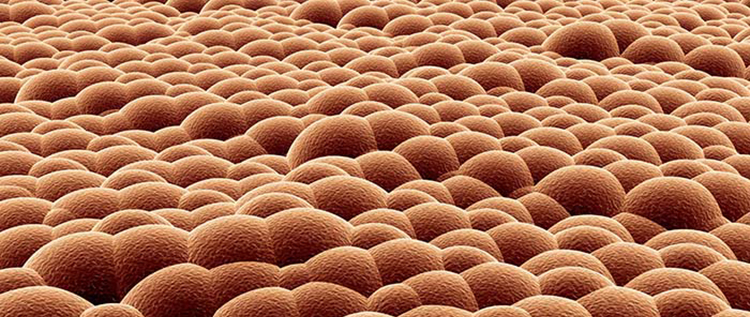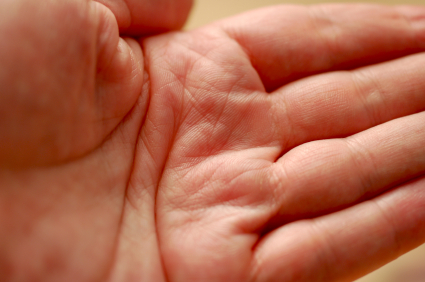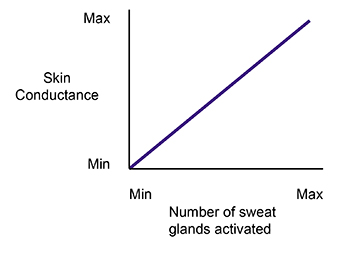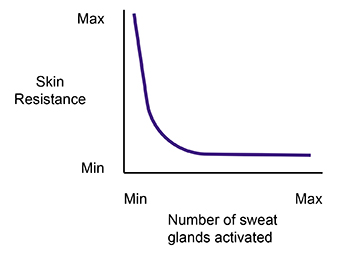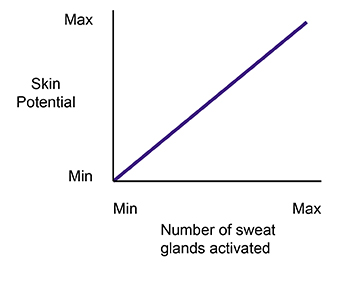
The
epidermis comprises five
layers (stratum corneum, stratum lucidum, stratum granulosum, stratum
spinosum, and stratum germinativum). The
dermis contains blood and lymph
vessels, smooth muscle, and sebaceous and sweat glands. The secretory
portion of sweat glands is located in the
hypodermis. This region
consists of connective tissue below the dermis containing blood and lymph
vessels.
Graphic © Blamb/Shutterstock.com.
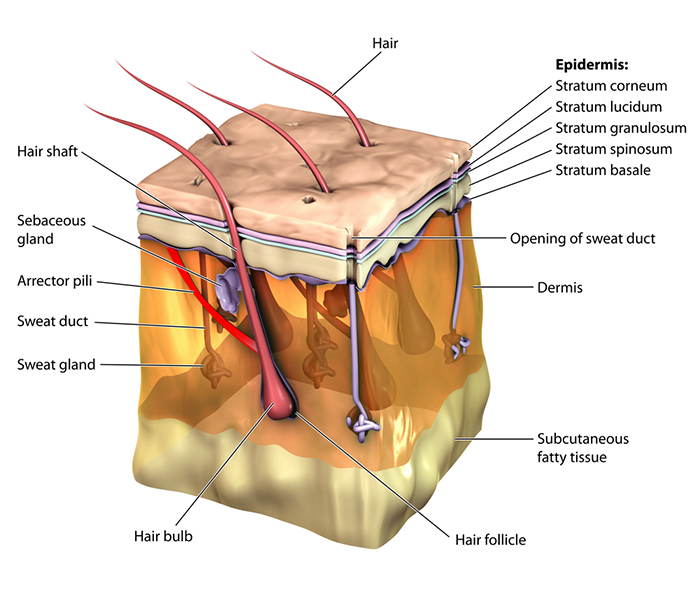
The human skin contains three-to-four million
sudoriferous glands (sweat glands), including apocrine and eccrine sweat glands (Tortora & Derrickson, 2021).
Apocrine Sweat Glands
Apocrine sweat glands
have larger-diameter ducts and lumens than eccrine sweat glands (Tortora & Derrickson, 2021). They usually open into hair follicles and are mainly distributed in the
armpits, bearded male facial areas, breast areolae, and genital region. They secrete sweat using exocytosis. White- or yellow-colored apocrine sweat produces a musky odor when combined with skin surface bacteria. Apocrine sweat begins during puberty and is released during emotional reactions and sexual activity. Apocrine sweat glands play no role in thermoregulation. Graphic © Timonina/Shutterstock.com.
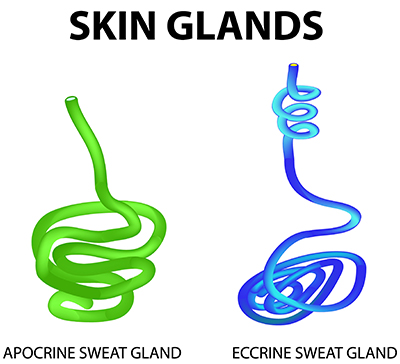
Eccrine Sweat Glands
Eccrine sweat glands are mainly responsible for EDA and are distributed across the body surface, mainly the forehead, palms, and soles, and are more numerous than apocrine sweat glands (Tortora & Derrickson, 2021). Eccrine sweat glands are not found in the clitoris, labia minora, glans penis, eardrums, lip margins, nail beds of the fingers and toes, and the outer ear. A square inch of the palmar
surface may contain about 3,000 sweat glands (Jacob & Francone, 1970).
Cadaver studies indicate that the entire body may have 2-5
million sweat glands (Fowles, 1986).
Thermoregulation
Peripheral and central thermoreceptors monitor body temperature.
They report temperature changes to the
preoptic area of the hypothalamus and other brain regions (Breedlove & Watson, 2020). When body temperature rises, the preoptic area activates the heat-loss center and suppresses the heat-promoting center. The heat-loss center signals skin blood vessels to dilate to radiate heat into the environment. The hypothalamus activates sympathetic nerves that innervate eccrine sweat glands to initiate
thermoregulation
(temperature control) through evaporative cooling. This mechanism is active after birth (Tortora & Derrickson, 2021). Graphic © Blamb/Shutterstock.com.
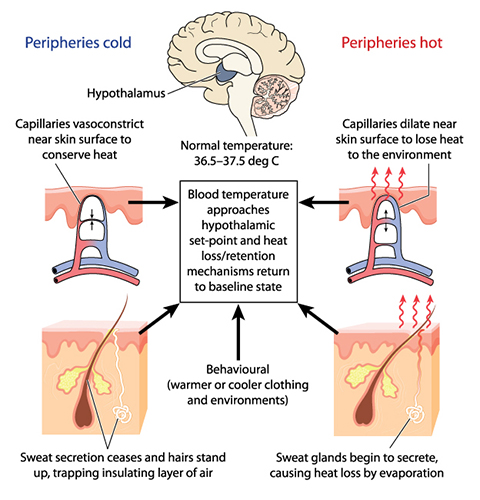
Thermoregulatory sweating starts at the forehead and scalp, and last appears on the palms and soles. This order is not accidental since forehead and scalp sweating sheds the largest amount of heat from the body. In contrast,
emotional sweating in response to fear or anxiety begins at the palms, soles, and armpits. Apocrine sweat glands also participate in emotional sweating.
Emotional Sweating
While all eccrine
sweat glands respond to cognitive activity, emotion, and temperature, palmar and plantar sweat
glands appear more responsive to emotional stimuli because of higher
density (about 1,000 glands per cm
2 compared with 100-200 per cm
2 on the
trunk and limbs). Palmar and plantar sweating seems specialized for grasping objects,
increasing tactile sensitivity, and protecting skin from damage (Dawson et al., 2016; Hugdahl,
1995).
These changes support the human fight-or-flight response.

Eccrine Sweat Glands
Eccrine Sweat Gland Anatomy
An eccrine sweat gland consists of a secretory portion and sweat duct.
The
secretory portion that produces sweat consists of coils arranged in
a ball 0.3-0.4 mm in diameter. In the graphic © Tefi/Shutterstock.com, sweat glands are shown in purple.
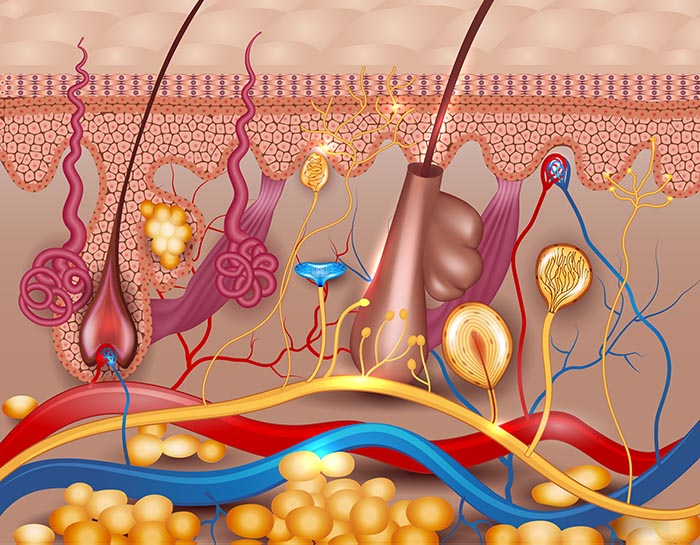
Sympathetic cholinergic fibers mainly innervate eccrine sweat glands. Unmyelinated cholinergic fibers are densest around the secretory
portion. A few lie close to the duct. Researchers have also found
nearby adrenergic fibers. Neurotransmitters like VIP may complement ACh
and NE (Bach, 2014; Shields et al., 1987).
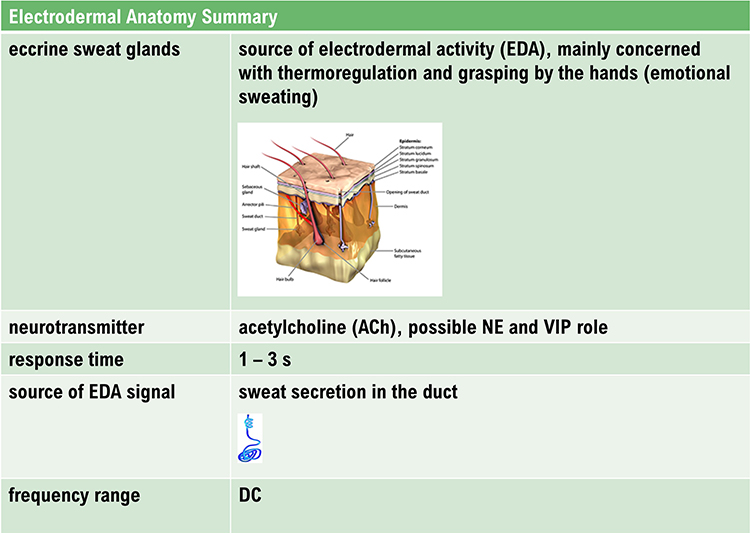
Sweat gland coils are lined by
myoepithelial cells
that resemble smooth muscle cells. Myoepithelial cells may help produce
spontaneous EDA. They are influenced by
the hormones norepinephrine (NE) and possibly epinephrine (E). The sweat duct is a long tube that excretes sweat through a
pore at the epidermis. Check out the Encyclopedia Britannica YouTube video
Eccrine Glands.
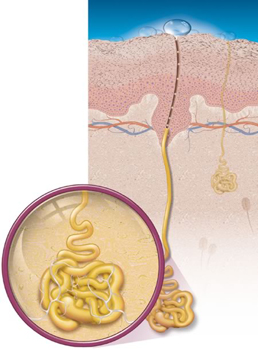
Caption: The magnified area is a sweat gland's secretory portion.
Timelapse video of fingertip sweat glands © Timelapse Vsion Inc. from Sploid.
EDA is typically recorded from the fingers and palmar surface of the hands. Different body areas (e.g., armpit) may respond differently to diverse stimuli. Only a few studies have monitored EDA from other regions, such as the forehead when training patients to inhibit motion sickness (Shaffer, Combatalade, Peper, & Meehan, 2016).
The
sympathetic nervous system (SNS), the autonomic
nervous system branch regulating activities that expend stored energy, primarily controls EDA. This view is
supported by the strong correlation between sympathetic action potentials
and skin conductance responses (SCRs) at average room temperature (Wallin,
1981). Increased SNS activation results in greater
sweating from the palms.
EDA amplitude does not increase equally in both hands. Discrepancies between left- and right-hand values mainly reflect left/right brain function but may also signal pathology (Banks et al., 2012). Skin responses may also be affected by the particular dermatomes (areas of skin innervated by a single spinal nerve) activated.
The graphic below depicts the autonomic nervous system ©
2003 Josephine Wilson.
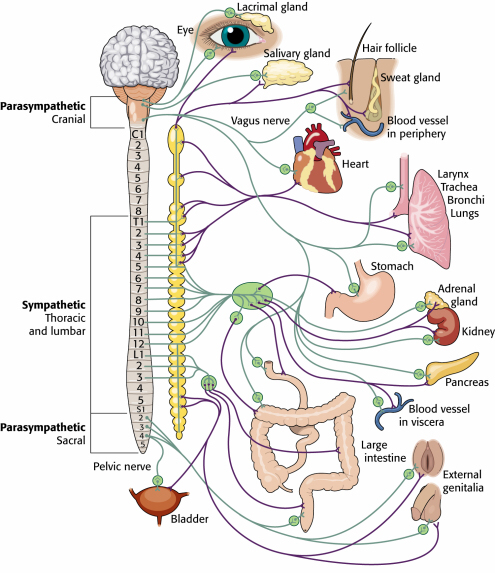
Sweat Production
Sympathetic fibers release
acetylcholine (ACh) to trigger sweating. ACh
binds to the secretory portion allowing calcium ions to enter and
stimulate sweating by acting as a second messenger. The role of
noradrenergic fibers in sweating remains unclear (Fowles, 1986). Human
sweat begins as plasma-like precursor sweat. Sweat mainly comprises water, ions (Na+ and Cl-), amino acids, ammonia, glucose, lactic acid, urea, and uric acid (Tortora & Derrickson, 2021). The sweat duct reabsorbs
sodium chloride from sweat.
Why is ACh released to trigger sweating instead of NE, the postsynaptic transmitter throughout the SNS?
The substitution of ACh for NE makes sense when we remember that ACh
typically controls
exocrine glands (glands that secrete into ducts).
Eccrine sweat glands are also exocrine glands. They secrete sweat into
ducts that open on the skin surface.
Interestingly, the sympathetic motor neurons innervating eccrine sweat
glands are programmed to secrete NE but are
instructed by the sweat glands to release ACh instead.
Edelberg's (1993) Poral Valve Model
Edelberg (1972) described the long, tubular sweat ducts as
resistors
(which can assume varying values) wired in parallel. Even when we are
exposed to a loud sound, not all sweat glands are active simultaneously. Further, an individual sweat gland's activity falls on a continuum.
Since sweat column height (resistor value) reflects the degree of
activity, the higher sweat rises, the larger the response amplitudes.
Edelberg (1993) explained the rapid shift from conductance to resistance in the
sweat circuit model with his
poral valve model. Initially, the sweat duct
is empty, and the pore at the skin surface is closed (A). Sweat secretion
rises in the duct, increasing skin conductance, and the pore remains
closed (B). Sweat fills the duct until pressure forces the
poral valve open, producing maximum skin conductance (C). Loss of sweat
to the skin surface reduces the intraductal pressure needed to keep the
poral valve open, causing it to close and conductance to decline rapidly
(D). The illustration below was adapted by John Balven from Edelberg (1993).
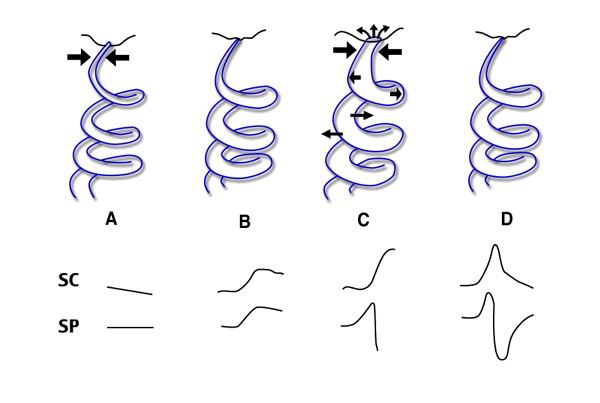
CNS Control of EDA
Human neuroimaging research has shown that when the ventromedial prefrontal cortex (VMPFC), right inferior parietal
cortex, and anterior cingulate (ACC) evaluate stimulus
significance or
salience, this results in SCRs. When these regions, in concert with the amygdala and the orbitofrontal cortex, evaluate the
emotional significance of a
stimulus, this also generates SCRs (Dawson et al., 2016; LaBar et al., 1998).
Hugdahl's (1995) Model
Hugdahl (1995) proposed that locomotor, orienting-activating, and
thermoregulatory systems centrally control EDA.
The
locomotor system (premotor cortex, pyramidal tract, and brainstem)
hydrates the soles of the feet and palms of the hands to increase running
speed and hand dexterity.
The
orienting-arousal system (lateral frontal cortex, amygdala and
hippocampus, and reticular formation) produces sweating to protect the
skin from injury in situations demanding focused attention (e.g., novel
stimuli) or vigilance for threats.
The
thermoregulatory system (anterior hypothalamus) produces cold
sweating during trauma. Increased sweating is accompanied by
constriction of peripheral blood vessels and increased electrodermal
activity in the hands and digits. Emotional sweating is not observed during sleep or sedation (Sato et al., 1989).
Boucsein's (1992) Model
Boucsein (1992) proposed that EDA in the hand is
centrally regulated by contralateral (control by the opposite side of the brain) and ipsilateral (control by the same side of the brain) systems that each contain excitatory and inhibitory
circuits.
Animal studies, mainly using cats, have provided most of our information about the central mechanisms that
produce EDA.
The
contralateral system constitutes the highest level of central control over
EDA, involves the
lateral prefrontal cortex, premotor cortex, and the basal ganglia, and generates EDA during cognition, orienting,
and locomotion. The
ipsilateral system constitutes the second level of
central EDA control, involving the amygdala, hippocampus, and hypothalamus. The ipsilateral system generates EDA during emotional
responses.
The
brainstem reticular formation constitutes the lowest level of
central EDA control. This system initiates EDA when we encounter novel or important stimuli (Dawson et al., 2016).
Hemispheric Asymmetry
The controversy over the role of both brain hemispheres in electrodermal
activity continues. Disagreement is partly due to confounding sensorimotor tasks with
cognitive and emotional tasks. Research suggests different roles for the left and right brain
hemispheres in control of arousal, orientation, and habituation. Findings support the view that the contralateral pathways responsible for
bilateral differences in EDA are excitatory (Davidson et al., 1992).
Factors That Influence EDA
Temperature influences EDA since the primary function
of eccrine sweat glands is to regulate body temperature. SCL rises with room humidity and temperature increases due to increased corneum hydration (Boucsein et al., 2012; Dawson et al., 2016).
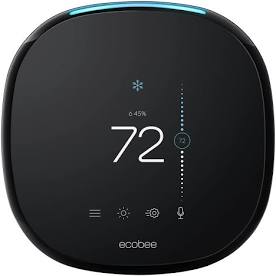
Gender
differences in skin conductance level and reactivity may disappear when
researchers control for a participant's most reactive hand (Roman et al.,
1989). Boucsein (1992) reported lower SCLs for Black
participants than their White counterparts. Racial SCL differences may be due to fewer sweat glands in dark skin.
EDA declines with aging. Finally, muscle relaxants reduce electrodermal
activity.
Behavioral Correlates of EDA
Skin potential response (SPR) can exhibit a monophasic negative or
positive waveform, biphasic waveform (negative, then positive), or
triphasic waveform (negative, positive, then negative). The classic
pattern is biphasic. The illustration below was adapted from Stern, Ray, and Quigley (2001).
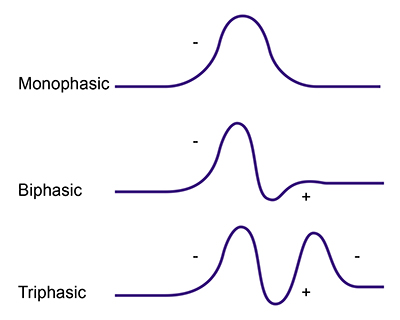 Monophasic negative SPRs
Monophasic negative SPRs are associated with slow recovery times. This
pattern may be part of a defensive reaction (sweat reduces abrasive
injury).
Biphasic SPRs (negative, then positive) involve a rapid return to
baseline. This pattern reflects the rapid sweat reabsorption seen in
goal-directed behavior. Moisture is reduced to improve manipulation by
the digits (Edelberg, 1970).
Skin potential may provide more information than skin conductance. Edelberg
(1973) argued that skin potential contains an epidermal
component, absent in skin conductance, in addition to a shared sweat
gland component. While SPRs require sweat gland activity, SPLs are still
seen when sweat gland activity is blocked with atropine (Venables &
Martin, 1967).
Labiles and Stabiles
Katkin (1975) argued: “EDA is a personality variable that reflects individual differences in higher central processes involved in attending to and processing information” (p. 172).
Researchers have divided subjects into labiles and stabiles to describe
SCL/SCR, information processing, and personality differences in electrodermal variability.
Labiles differ from stabiles in EDA, vigilance, and personality. Labiles show higher
resting SCLs and larger SCRs, and more rapid responses to stimuli and
return to prestimulus levels than stabiles. Their vigilance and performance in signal detection tasks are superior. Finally, they better control overt emotional expression (e.g., facial expression) and are more agreeable than stabiles (Dawson et al., 2016).
Graphic
©
Dean Drobot/Shutterstock.com.

These differences support the
view that labiles better respond to changing environmental demands and allocate attentional resources to environmental events (Schell,
Dawson, & Filion, 1988).

Glossary
acetylcholine (ACh): a neurotransmitter that binds to the secretory portion
allowing calcium ions to enter and stimulate sweating by acting as a second messenger.
apocrine sweat glands: glands that usually open into hair follicles and are
mainly distributed in the armpits and genital region. They produce sweat odor, and distress can expel sweat from
their tubules.
biphasic SPR: a skin potential response (SPR) that starts with a negative
phase and then ends with a positive phase.
contralateral system: in Boucsein’s model of EDA control, a system that controls the hand's sweat gland activity on the opposite side of the brain. This system expresses activity in
the lateral prefrontal cortex and the basal ganglia or BG (i.e., caudate nucleus and putamen), and mediates
EDA during cognition, orienting, and locomotion.
dermis: the inner skin layer that contains blood and lymph vessels, smooth
muscle, and sebaceous and sweat glands.
eccrine sweat glands: glands that respond to cognitive activity, emotion, and
temperature, achieve thermoregulation (temperature control) through evaporative cooling and are responsible for
EDA.
emotional sweating: sweating that begins at the palms, soles, and armpits in response to fear or embarrassment.
endosomatic: from within the body. Skin potential is measured by detecting
voltage differences between two electrodes on the skin surface.
epidermis: outer skin layer that consists of five layers (stratum corneum,
stratum lucidum, stratum granulosum, stratum spinosum, and stratum germinativum).
exocrine glands: glands that secrete into ducts.
exosomatic: from outside the body. Skin conductance and skin resistance are
measured by passing an electric current through the skin.
hypodermis: the region below the dermis that consists of connective tissue and
contains the secretory portion of sweat glands and blood and lymph vessels.
ipsilateral system: in Boucsein’s model of EDA control, a system that
controls the sweat gland activity of the hand on the same side of the brain.
labiles: individuals who show higher resting SCLs and larger SCRs, and more
rapid responses to stimuli and return to resting levels, less overt emotional expression, and more agreeableness than stabiles. Labiles may better respond to changing
environmental demands and allocate attentional resources to environmental events.
level: a tonic measure of EDA that quantifies the average
amplitude over a specified period.
locomotor system: in Hugdahl’s model of EDA control, this system
consists of the premotor cortex, pyramidal tract, and brainstem. The locomotor system hydrates the soles of the feet and palms of
the hands to increase running speed and hand dexterity.
Malpighian layer: the deepest layer of the epidermis. Sweat glands are typically
filled to this layer.
monophasic negative SPRs: skin potential response (SPR) with one negative
limb.
myoepithelial cells: the cells that line the coils of the secretory portion of a
sweat gland. Myoepithelial cells produce sweat and may contribute to spontaneous EDA.
orienting-arousal system: in Hugdahl’s model of EDA control, this system
consists of the lateral frontal cortex, amygdala and hippocampus, and reticular formation. The orienting-arousal system produces sweating
to protect the skin from injury in situations demanding focused attention (e.g., novel stimuli) or vigilance for
threats.
phasic: a brief change in physiological activity in response to a discrete
stimulus. For example, a single skin potential response in reaction to a sudden tone.
poral valve model: Edelberg’s revised model of a skin conductance
response (SCR) in which rising levels of sweat in the duct open a poral valve, depositing sweat on the skin
surface.
preoptic area of the hypothalamus: forebrain structure that receives reports of body temperature and activates sympathetic nerves that innervate eccrine sweat glands to initiate thermoregulation through evaporative cooling.
resistance: the reciprocal of conductance, also called galvanic skin response
(GSR), that reflects opposition to external current movement and is measured as skin resistance level (SRL) and
skin resistance response (SRR) in Kohms (thousands of ohms).
resistor: an electrical or electronic component that opposes electrical current
flow. Edelberg described the long, tubular sweat ducts as resistors wired in parallel.
response: a phasic measure of EDA representing a
spontaneous or stimulus-elicited change in sweat gland activity.
secretory portion: the coils of an eccrine sweat gland that produce sweat.
skin conductance: an exosomatic measure of EDA that indexes how easily an
external current passes through the skin that is measured as
skin conductance level (SCL) and
skin
conductance response (SCR) in microsiemens (formerly micromhos).
skin conductance level (SCL): a tonic measure of skin conductance
measured in microsiemens.
skin conductance response (SCR): a phasic measure of skin conductance
measured in microsiemens.
skin potential: an endosomatic measure of EDA that detects voltage differences
between two electrodes on the skin surface. Skin potential is measured as
skin potential level (SPL) and
skin potential response (SPR) in millivolts (thousandths of a volt).
skin potential level (SPL): a tonic measure of skin potential measured
in millivolts.
skin potential response (SPR): a phasic measure of skin potential
measured in millivolts.
skin resistance: an exosomatic measure of EDA that reflects opposition to
current movement and is measured as
skin resistance level (SRL) and
skin resistance response
(SRR), also called galvanic skin response (GSR), in Kohms (thousands of ohms).
skin resistance level (SRL): a tonic measure of skin resistance measured
in Kohms.
skin resistance response (SRR): a phasic measure of skin resistance
measured in Kohms.
stabiles: individuals who show lower resting SCLs and smaller SCRs, slower
responses to stimuli and return to resting levels, more overtly emotionally expressive, and more antagonistic than labiles. They seem less effective than labiles in responding to changing environmental demands and allocating attentional resources to environmental events.
sudoriferous glands: apocrine and eccrine sweat glands.
sweat circuit model: Edelberg’s hypothesis that EDA is a function of
sweat duct filling and action by a selective membrane in the epidermis. He proposed that duct-filling produces
SCRs, while both duct-filling and the selective membrane control response recovery.
sympathetic cholinergic fibers: unmyelinated sympathetic motoneurons that
mainly innervate eccrine sweat glands. These motoneurons release ACh at the secretory portion. A few
may target the sweat duct.
sympathetic nervous system: autonomic nervous system branch that regulates
activities that expend stored energy and primarily controls EDA.
thermoregulation: temperature control through evaporative cooling.
thermoregulatory system: in Hugdahl’s model of EDA control, this system
lies in the anterior hypothalamus and produces cold sweating during trauma. Increased sweating is
accompanied by constriction of peripheral blood vessels and increased EDA in the hands and
digits.
tonic: the background level of physiological activity. For example, a 5-minute
average of skin conductance activity.
Test Yourself
Click on the ClassMarker logo to take 10-question tests over this unit without an exam password.

REVIEW FLASHCARDS ON QUIZLET
Click on the Quizlet logo to review our chapter flashcards.

Visit the BioSource Software Website
BioSource Software offers
Human Physiology, which satisfies BCIA's Human Anatomy and Physiology requirement, and
Biofeedback100, which provides extensive multiple-choice testing over BCIA's Biofeedback Blueprint.

Assignment
Now that you have completed this module, describe the difference between
level and response, exosomatic and endosomatic measurements, and labiles
and stabiles. Summarize the main reasons for palmar sweating.
References
Andreassi, J. L. (2007).
Psychophysiology: Human behavior and physiological
response (5th ed.). Lawrence Erlbaum and Associates, Inc.
Bach, D. R. (2014). Sympathetic nerve activity can be estimated from skin conductance responses: A comment on Henderson et al. (2012).
NeuroImage, 84, 122-123. https://doi.org/10.1016/j.neuroimage.2013.08.030
Banks, S. J., Bellerose, J., Douglas, D., & Jones-Gotman, M. (2012). Bilateral skin conductance responses to emotional faces.
Applied Psychophysiology and Biofeedback, 37(3), 145-152. https://doi.org/10.1007/s10484-011-9177-7
Breedlove, S. M., & Watson, N. V. (2020).
Behavioral neuroscience (9th ed.). Sinauer Associates.
Dawson, M. E., Schell, A. M., & Filion, D. L. (2016). The electrodermal system. In J. T. Cacioppo, L. G.
Tassinary, & G. G. Berntson (Eds.).
Handbook of
psychophysiology (4th ed.)
. Cambridge University Press.
Edelberg, R. (1993). Electrodermal mechanism: A critique of the
two-effector hypothesis and a proposed replacement. In J. C. Roy, W.
Boucsein, D. C. Fowles, and J. H. Gruzelier (Eds.),
Progress in
electrodermal research, pp. 7-30. Plenum Press.
Fowles, D. C. (1986). The eccrine system and electrodermal activity. In M. G. H. Coles, E. Donchin, & S. W. Porges (Eds.).
Psychophysiology, systems, processes & applications (pp 51-96).
Guilford.
Hugdahl, K. (1995).
Psychophysiology: The mind-body perspective. Harvard University
Press.
Jacob, S. W., & Francone, C. A. (1970).
Structure and function in man. Saunders.
LaBar, K. S., Gatenby, J. C., Gore, J. C., LeDoux, J. E., & Phelps, E. A. (1998). Human amygdala activation during conditioned fear acquisition and extinction: A mixed-trial fMRI study.
Neuron, 20, 937-945. https://doi.org/10.1016/s0896-6273(00)80475-4
Lacey, J. I., & Lacey, B. C. (1958). The relationship of resting autonomic activity to motor impulsivity. In J.
I. Lacey & B. C. Lacey (Eds.).
The brain and human behavior (pp. 144-209). Williams & Wilkins.
Sato, K., Kang, W. H., Saga, K., & Sato, K. T. (1989).
Biology of sweat glands and their disorders. II. Disorders of sweat gland function.
J Am Acad Dermatol, 20, 713-726. https://doi.org/10.1016/s0190-9622(89)70081-5
M. S.
Schwartz, & F. Andrasik (Eds.). (2003).
Biofeedback: A practitioner's guide
(3rd ed.)
. The Guilford Press.
Shaffer, F., Combatalade, D., Peper, E., & Meehan, Z. (2016). A guide to cleaner electrodermal activity measurements.
Biofeedback, 44(2), 90-100. https://doi.org/10.5298/1081-5937-44.2.01
Shields, S. A., MacDowell, K. A., Fairchild, S. B., & Campbell, M. L. (1987). Is mediation of sweating
cholinergic, adrenergic, or both? A comment on the literature.
Psychophysiology, 24(3), 312-319. https://doi.org/10.1111/j.1469-8986.1987.tb00301.x
Stern, R. M., Ray, W. J., & Quigley, K. S. (2001).
Psychophysiological
recording (2nd ed.). Oxford University Press.
Tortora, G. J., & Derrickson, B. H. (2021).
Principles of anatomy and
physiology (16th ed.)
. John Wiley & Sons, Inc.


